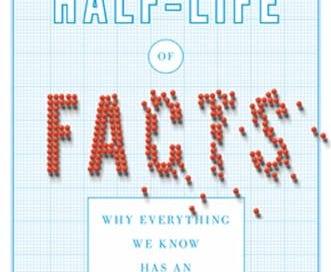The Half-Life of Facts: Why Everything We Know Has an Expiration Date
By Samuel Arbesman
“Every day that we read the news, we have the possibility of being confronted with a fact about our world that is wildly different from what we thought we knew.”
In The Half-Life of Facts: Why Everything We Know Has an Expiration Date, author Samuel Arbesman delves into the dynamic nature of knowledge, revealing how facts evolve systematically over time. Among the more than 50 books I read in 2024, this one stood out for its compelling examination of how much of what we accept as truth today may be disproved tomorrow. Understanding this phenomenon is crucial, as it underscores the importance of adaptability and continuous learning in our ever-changing world.
What’s the big deal?
Arbesman introduces the concept of the half-life of facts, drawing a parallel to radioactive decay. Just as radioactive substances decay at a predictable rate, some bodies of knowledge exhibit a measurable rate of change, he writes, with established facts becoming obsolete over time. For instance, medical knowledge about cirrhosis or hepatitis has a half-life of approximately 45 years, meaning half of what is known today will be outdated in 45 years.
This phenomenon extends beyond medicine. Take astronomy: For centuries, scientists believed our solar system had a fixed number of planets. As classification standards evolved, Pluto was redefined as a dwarf planet, and with improved technology, we discovered thousands of exoplanets—reshaping planetary science.
What was once an absolute fact in textbooks is now outdated or significantly revised.
Another striking example comes from nutrition science. Decades ago, margarine was promoted as a healthier alternative to butter due to concerns over saturated fat. However, later research on trans fats showed margarine could be worse for heart health than butter, prompting a shift in dietary recommendations. The once widely accepted guideline changed completely, highlighting how even well-established health advice evolves with new evidence.
Five key takeaways
Knowledge decay is inevitable: Facts are not static; they change as new discoveries emerge. Recognizing this helps us remain open to updating our beliefs.
Disciplines evolve at different rates: Fields like medicine experience rapid knowledge turnover, while areas like mathematics have more enduring truths. This variance necessitates tailored approaches to learning in different domains.
The importance of continuous learning: Given the transient nature of facts, ongoing education is essential to stay current and make informed decisions.
Awareness of mesofacts: Some facts change at a moderate pace, such as nutritional guidelines. Staying informed about these “mesofacts” can significantly impact daily life and health choices.
Implications for education: Teaching should focus not only on imparting current knowledge but also on fostering critical thinking skills that enable students to adapt to future changes in understanding.
Why you should read the book
Arbesman’s exploration of the predictable patterns governing the evolution of knowledge is both enlightening and humbling. The Half-Life of Facts challenges us to reconsider the permanence of what we know and emphasizes the value of intellectual flexibility. For anyone intrigued by the fluidity of information and its implications, this book is a must-read.




